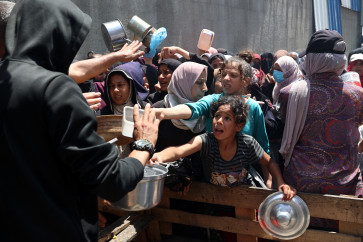Jakarta's floods and the changing climate
Heavy rain recently caused major disruptions to the flood-prone city of Jakarta
Change text size
Gift Premium Articles
to Anyone

H
eavy rain recently caused major disruptions to the flood-prone city of Jakarta.
While the rain subsided considerably, the Meteorology, Climatology and Geophysics Agency (BMKG) warned the wet season might persist for the entire month, requiring the city's residents to remain vigilant for further potential flooding.
The rain was, of course, not completely unexpected at this time of the year. In fact, Jakarta, due to its geographical and geological features, has been vulnerable to seasonal floods for centuries.
Nevertheless, despite mitigation efforts made by the authorities, it seems flooding remains an inescapable situation for the city's residents.
Unfortunately, as the Earth warms, we can expect intense rainfall and inundation to be more pronounced.
From a climatology science point of view, we have learnt that an increase in the planet's temperature will allow the earth's atmosphere to hold more water.
The larger the moisture capacity, the longer it takes to recharge the water vapor in the atmosphere to achieve its saturation point before it pours down in the form of rain.
Due to the combined factors of increased moisture capacity and water vapor recharge time, the rain we experience will be less frequent but with a higher intensity.
As a result, we should anticipate that the dry season will be drier and the wet season will be wetter.
Based on that scientific understanding of the Earth's climate system, climatologists have warned us that climate change will bring catastrophic effects by exacerbating the frequency and intensity of extreme weather events across the globe, such as prolonged droughts, heavy precipitation, tropical cyclones and heavy storms.
Certainly, many factors will come into play in determining the amount of rain we receive within a period of time.
For example, rain intensity will be much more intense during a La-Niña phenomenon compared to during El-Niño, which is often associated with long, dry periods. The planet's complex and dynamic system naturally produces highly variable rain intensity each year.
Nevertheless, when we make a long-term observation of precipitation data, changes in the rain pattern consistent with the scientific prediction of climate change begin to emerge.
The Intergovernmental Panel on Climate Change (IPCC), a scientific body under the auspices of the UN, which provides an internationally accepted authority on climate change, published its fifth assessment report in 2014, containing reviews on the evidence of climate change and its impact of our climate system.
The IPCC asserts that there is strong scientific evidence to support the fact that the global mean surface temperature has increased since the late 19th century. It noted that each of the past three decades has been successively warmer on the Earth's surface than all the previous decades on record, and the first decade of the 21st century has been the warmest.
Furthermore, atmospheric humidity has increased, particularly since the 1970s.
The IPCC also reports that a substantial body of research has enabled us to affirm that the frequency and magnitude of extreme precipitations has seen a significant increase during the last century, particularly for the Americas and Europe, and for the majority of Southeast Asia, including Indonesia.
These climate changes, the IPCC highlights, cannot be explained by natural variability alone, but rather must been caused by the increased carbon dioxide concentration attributed to human activities, often termed as an anthropogenic impact.
Should the planet be allowed to continue to warm, social and economic activities in Jakarta will most certainly be negatively affected.
A study by Yen Yi Loo in 2014 published in the Geoscience Frontier scientific journal, has found evidence linking the impact of climate change and an increased seasonality anomalous of the monsoon system in Asia, which in turn leads to the increased variability of monsoon rainfall in Southeast Asia, particularly Indonesia.
Data from the World Bank shows that the average monthly precipitation rate in Jakarta, despite showing a high year by year variation, has seen a consistent increase at a rate of 15.2 millimeters per month since 1900s.
An article published by the BMKG, written by Siswanto, a researcher at the agency, also highlights the potential risk posed by climate change to Jakarta's flooding problem.
The author analyzes the historical data of rain in Jakarta from 1912 until 2014 and draws a conclusion that the number of wet days (that is a day with less than 1 mm of precipitation) have reduced in the last century.
Nevertheless, the number of days with heavy rain with intensity above 50 mm have increased at least by 20 percent, especially during the last 40 years.
In sum, while Jakarta tends to see less rain today due to the reduction of rain frequency in the last century, the city has experienced more frequent heavy rain. This cannot be good for the city, which is already prone to a high variability of rain to begin with.
In conclusion, with the warming of the earth, Indonesia, and Jakarta in particular, will face a greater threat of extreme weather with both increased frequency and intensity.
We will most likely have bigger rainfall in wet seasons, in the months of January and February when we are the most vulnerable to flooding. And quite the opposite, we will have less rain in dry seasons when we actually might need it more.
This will prove to be disastrous, not only for the citizens of Jakarta but for the nation in general due to the city's strategic position as the nation's capital and largest industrial and economic hub.
As an illustration, the major floods that hit Jakarta in 2007 and 2013 caused not only casualties and displaced hundreds of thousands of people, but also economic losses that ran into trillions of rupiah.
Without a concerted effort from all authorities and citizens in general to ensure a more sustainable and climate adaptive path of development, our city will be more vulnerable to the disastrous impact of flooding that has accompanied us for centuries.
___________________
The writer holds a Master's of Science degree from the Environmental Change Institute, University of Oxford, and is a policy analyst at the Finance Ministry. The views expressed are his own.









